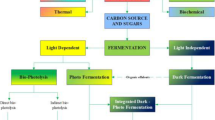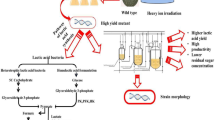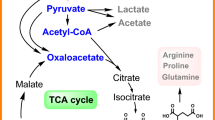Abstract
Thermoanaerobacter mathranii can produce ethanol from lignocellulosic biomass at high temperatures, but its biotechnological exploitation will require metabolic engineering to increase its ethanol yield. With a cofactor-dependent ethanol production pathway in T. mathranii, it may become crucial to regenerate cofactor to increase the ethanol yield. Feeding the cells with a more reduced carbon source, such as mannitol, was shown to increase ethanol yield beyond that obtained with glucose and xylose. The ldh gene coding for lactate dehydrogenase was previously deleted from T. mathranii to eliminate an NADH oxidation pathway. To further facilitate NADH regeneration used for ethanol formation, a heterologous gene gldA encoding an NAD+-dependent glycerol dehydrogenase was expressed in T. mathranii. One of the resulting recombinant strains, T. mathranii BG1G1 (Δldh, P xyl GldA), showed increased ethanol yield in the presence of glycerol using xylose as a substrate. With an inactivated lactate pathway and expressed glycerol dehydrogenase activity, the metabolism of the cells was shifted toward the production of ethanol over acetate, hence restoring the redox balance. It was also shown that strain BG1G1 acquired the capability to utilize glycerol as an extra carbon source in the presence of xylose, and utilization of the more reduced substrate glycerol resulted in a higher ethanol yield.




Similar content being viewed by others
References
Bradford MM (1976) A rapid and sensitive method for the quantitation of microgram quantities of protein utilizing the principle of protein-dye binding. Anal Biochem 72:248–254
Brinen LS, Canaves JM, Dai X, Deacon AM, Elsliger MA, Eshaghi S, Floyd R, Godzik A, Grittini C, Grzechnik SK, Guda C, Jaroszewski L, Karlak C, Klock HE, Koesema E, Kovarik JS, Kreusch A, Kuhn P, Lesley SA, McMullan D, McPhillips TM, Miller MA, Miller MD, Morse A, Moy K, Ouyang J, Robb A, Rodrigues K, Selby TL, Spraggon G, Stevens RC, van den Bedem H, Velasquez J, Vincent J, Wang X, West B, Wolf G, Taylor SS, Hodgson KO, Wooley J, Wilson IA (2003) Crystal structure of a zinc-containing glycerol dehydrogenase (TM0423) from Thermotoga maritima at 1.5 A resolution. Proteins 50:371–374
Bryant MP (1972) Commentary on the Hungate technique for culture of anaerobic bacteria. Am J Clin Nutr 25:1324–1328
Burton RM (1955) Methods in enzymology, vol 1. Academic Press, New York, p 397
Dien BS, Cotta MA, Jeffries TW (2003) Bacteria engineered for fuel ethanol production: current status. Appl Microbiol Biotechnol 63:258–266
Georgieva T, Mikkelsen MJ, Ahring BK (2008) Ethanol production from wet-exploded wheat straw hydrolysate by thermophilic anaerobic bacterium Thermoanaerobacter BG1L1 in a continuous immobilized reactor. Appl Biochem Biotechnol 145:99–110
Germain P, Toukourou E, Donaduzzi L (1986) Ethanol production by anaerobic thermophilic bacteria: regulation of lactate dehydrogenase activity in Clostridium thermohydrosulfuricum. Appl Microbiol Biotech 24:300–305
Huber R, Langworthy TA, Köning H, Thomm M, Woese CR, Sleytr UB, Stetter KO (1986) Thermotoga maritima sp. nov. represents a new genus of unique extremely thermophilic eubacteria growing up to 90 °C. Arch Microbiol 144:324–333
Hungate RE (1969) A roll tube method for the cultivation of strict anaerobes. Meth Microbiol 3B:117–132
Ingram LO, Aldrich HC, Borges AC, Causey TB, Martinez A, Morales F, Saleh A, Underwood SA, Yomano LP, York SW, Zaldivar J, Zhou S (1999) Enteric bacterial catalysts for fuel ethanol production. Biotechnol Prog 15:855–866
Jones DT, Woods DR (1991) Clostrida. Plenum Pres, New York
Larsen L, Nielsen P, Ahring BK (1997) Thermoanaerobacter mathranii sp. nov., an ethanol-producing, extremely thermophilic anaerobic bacterium from a hot spring in Iceland. Arch Microbiol 168:114–119
Lynd LR (1989) Production of ethanol from lignocellulosic materials using thermophilic bacteria: critical evaluation of potential and review. Adv Biochem Eng 38:1–52
Lynd LR, Weimer PJ, van Zyl WH, Pretorius IS (2002) Microbial cellulose utilization: fundamentals and biotechnology. Microbiol Mol Biol Rev 66:506–577
Mikkelsen MJ, Ahring BK (2007) Thermoanaerobacter mathranii strain BG1. WO patent application 2007134607
Mikkelsen MJ, Yao S (2010) Increased ethanol production in recombinant bacteria. WO patent application 2010010116
Mitchell WJ (1998) Physiology of carbohydrate to solvent conversion by clostridia. Adv Microb Physiol 39:31–130
Nielsen J, Villadsen J, Gunnar L (2003) Bioreaction engineering principles. Kluwer Academic/Plenum Publisher, New York
Pronk JT, Kuijper SM, Toirkens MJ, Winkler R, van Dijken H, de Laat W (2005) Engineering Saccharomyces cerevisiae for xylose utilization. J Biotechnol 118:S86–S87
Sambrook J, Russell DW (2001) Molecular cloning: a laboratory manual. Cold Spring Harbor Laboratory, Cold Spring Harbor
Shaw AJ, Jenney FE, Adams MWW, Lynd LR (2008a) End-product pathways in the xylose fermenting bacterium, Thermoanaerobacterium saccharolyticum. Enzyme Microb Technol 42:453–458
Shaw AJ, Podkaminer KK, Desai SG, Bardsley JS, Rogers SR, Thorne PG, Hogsett DA, Lynd LR (2008b) Metabolic engineering of a thermophilic bacterium to produce ethanol at high yield. PNAS 105(37):13769–13774
Soboh B, Linder D, Hedderich R (2004) A multisubunit membrane-bound [NiFe] hydrogenase and an NADH-dependent Fe-only hydrogenase in the fermenting bacterium Thermoanaerobacter tengcongensis. Microbiology 150:2451–2463
Sommer P, Georgieva T, Ahring BK (2004) Potential for using thermophilic anaerobic bacteria for bioethanol production from hemicelluloses. Biochem Soc Trans 32:283–289
Sonne-Hansen J, Mathrani IM, Ahring BK (1993) Xylanolytic anaerobic thermophiles from Icelandic hot-springs. Appl Microbiol Biotechnol 38:537–541
Taylor MP, Eley KL, Martin S, Tuffin MI, Burton SG, Cowan DA (2009) Thermophilic ethanologenesis: future prospects for second-generation bioethanol production. Trends Biotechnol 27:398–40
Tyurin MV, Desai SG, Lynd LR (2004) Electrotransformation of Clostridium thermocellum. Appl Environ Microbiol 70:883–890
Vasconcelos I, Girbal L, Soucaille P (1994) Regulation of carbon and electron flow in Clostridium acetobutylicum grown in chemostat culture at neutral pH on mixtures of glucose and glycerol. J Bacteriol 176(5):1443–1450
Yanase H, Nozaki K, Okamoto K (2005) Ethanol production from cellulosic materials by genetically engineered Zymomonas mobilis. Biotechnol Lett 27:259–263
Yao S (2008) Metabolic engineering of ethanol production in Thermoanaerobacter mathranii BG1. PhD Thesis, Risø -Technical University of Denmark, Roskilde
Yazdani SS, Gonzalez R (2007) Anaerobic fermentation of glycerol: a path to economic viability for the biofuels industry. Curr Opin Biotechnol 18:213–219
Zaldivar J, Nielsen J, Olsson L (2001) Fuel ethanol production from lignocelluloses: a challenge for metabolic engineering and process integration. Appl Microbiol Biotechnol 56:17–34
Zeikus JG, Ben-Bassat A, Ng TK, Lamed RJ (1981) Thermophilic ethanol fermentations. In: Hollaender A (ed) Trends in the biology of fermentations for fuels and chemicals. Plenum Press, New York, p 441
Acknowledgments
We thank Slawomir Dabrowski (A&A Biotechnology, Poland) for kindly providing the pYPA vector, Karin Marie Due for taking good care of the continuous reactor, and Klaus Breddam for scientific and linguistic proofreading of the manuscript.
Author information
Authors and Affiliations
Corresponding author
Electronic supplementary material
Below is the link to the electronic supplementary material.
ESM 1
(DOC 113 kb)
Rights and permissions
About this article
Cite this article
Yao, S., Mikkelsen, M.J. Metabolic engineering to improve ethanol production in Thermoanaerobacter mathranii . Appl Microbiol Biotechnol 88, 199–208 (2010). https://doi.org/10.1007/s00253-010-2703-3
Received:
Revised:
Accepted:
Published:
Issue Date:
DOI: https://doi.org/10.1007/s00253-010-2703-3




